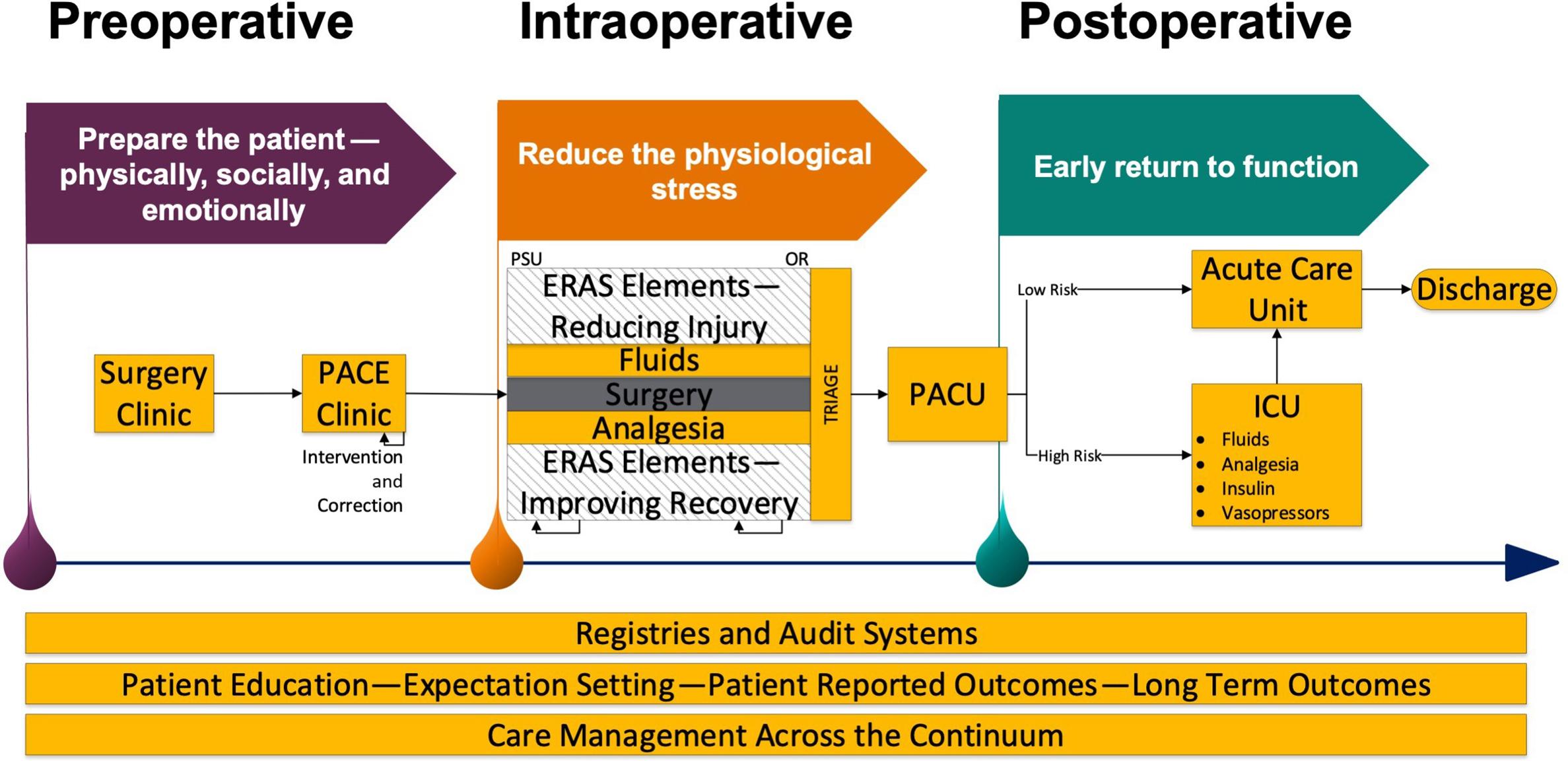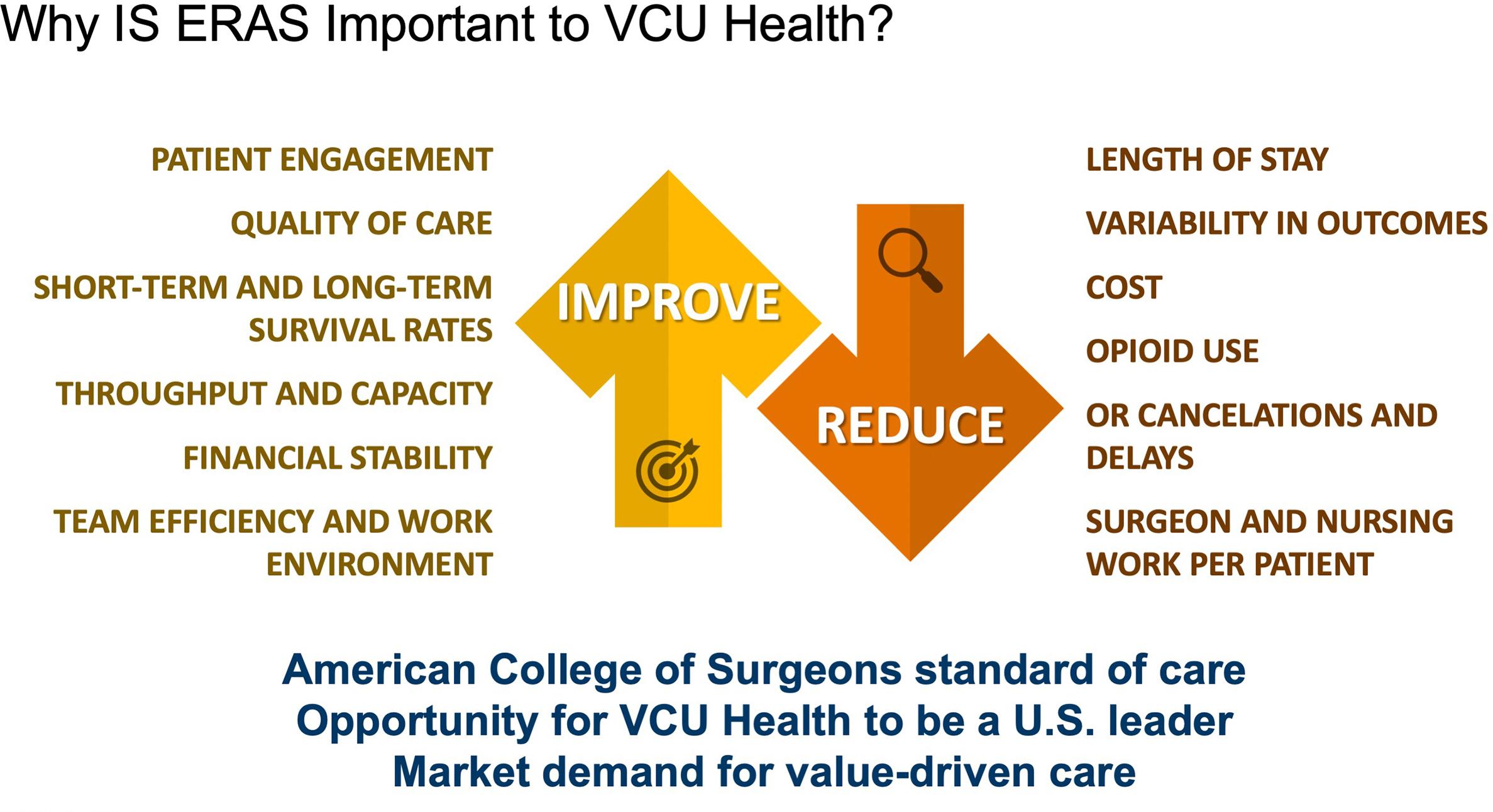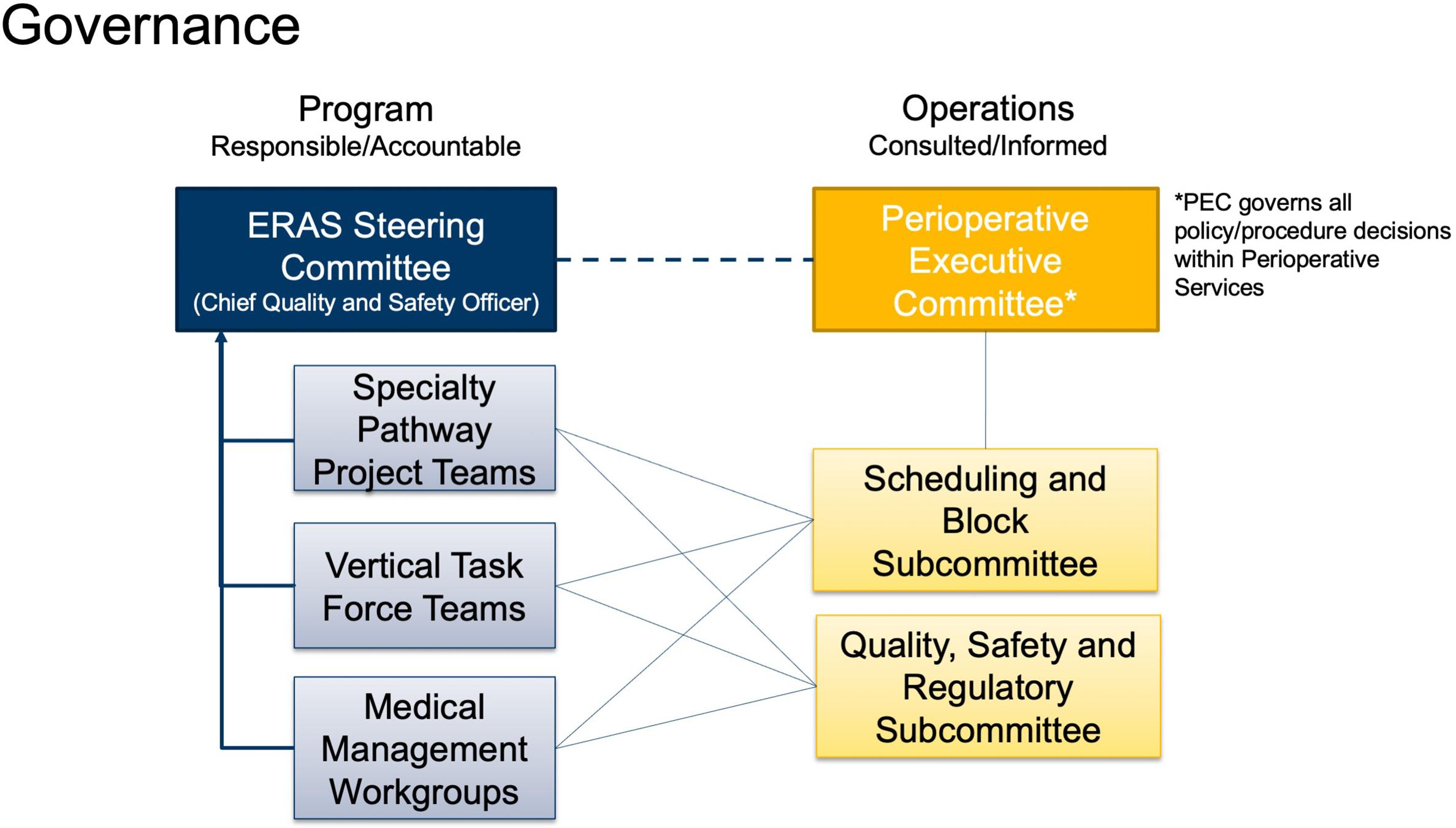Physical Address
304 North Cardinal St.
Dorchester Center, MA 02124
Enhanced Recovery After Surgery (ERAS) is a series of evidence-based protocols that improve outcomes after surgery by optimizing patients before surgery, reduce stress and injury during surgery, and promote rapid return of preoperative function.
ERAS pathways can be used as a framework for all health system surgical perioperative care pathways to reduce length of stay, improve quality, reduce variance, and improve patient satisfaction.
Executive leadership support is key to implementing an ERAS program across a health system.
Return on investment is high, meaning ERAS truly offers value-based health care.
Assembling a dedicated team of a medical director, quality improvement (QI) director, QI managers, and data analysts is likely to be necessary to tackle the enormity of health system transformation.
Initial outlay of costs is low and return on investment is high.
Surgical and anesthesia champions are needed with dedicated time.
Advanced practice providers, nurses, and all bedside providers need to be involved in pathway organization.
Vertical and horizontal implementation of ERAS principles accelerate the standardization of perioperative pathways across the health system.
Using the electronic medical record (EMR) can help drive real-time compliance of ERAS elements and produce audits but may require a lot of new resources in current EMR versions.
Data assessing the compliance of ERAS elements and complications, length of hospital stay, and direct and indirect costs can improve the process and guide ongoing QI projects.
Enhanced Recovery After Surgery (ERAS) pathways are multimodal, evidence-based perioperative care protocols designed to improve outcomes after surgery.
The concept was pioneered in the early 2000s by Henrik Kehlet, a Danish colorectal surgeon. In 2005, the ERAS Society was founded and published and formalized key elements of ERAS. The overall principle of ERAS is to optimize the patient's health before surgery, minimize stress to the body, maintain homeostasis, and restore function to normal rapidly. The result of ERAS pathways is a more predictable length of hospital stay (LOS) and reduced complications, without increased readmissions. ERAS principles can be applied to all types of elective surgery and even emergency general surgery. The cost of implementing ERAS is minimal but the challenges to reorganizing the surgical pathway can be significant. In the UK, the Enhanced Recovery Partnership successfully embedded ERAS as a standard of care in at least four specialties over 4 years across all UK hospitals. There have been consistent cost savings and improvements in patient care in other countries where ERAS has been implemented. In health systems where ERAS has been adopted as the standard (e.g., Alberta Health System, Canada), there have been net health system savings per patient ranging from $26.35 to $3606.44 and return on investment (ROI) ranging from 1.05 to 7.31, meaning that every dollar invested in ERAS brought $1.05 to $7.31 in return. The results of improved quality for less cost fits with the value-based proposition for United States (US) health care. Demand for elective surgical services continues to rise and the COVID-19 pandemic has put increased pressure on operating room (OR) utilization as the backlog of surgical cases is addressed. The increased bed capacity ERAS releases is an important aspect to help address this issue. Because the US has been unable to reduce healthcare costs despite attempts, the Centers for Medicaid and Medicare Services (CMS) and private payers are moving from pay per use to episode payment models to control costs with a focus on better outcomes. With the reduction in variance, increase in predictable LOS, and reduction in complications and readmissions as a result of ERAS pathways, ERAS can be a key pillar of delivering health care in the future.
Making ERAS principles the standard of care for all patients is one way to deliver care via reliable processes that afford better predictability of outcomes and costs.
In 2016, Virginia Commonwealth University (VCU) Health recruited Dr. Michael Scott (coauthor) from the UK (where he had been a National Lead for ERAS) as Lead for ERAS implementation and Medical Director to work in the Department of Clinical Effectiveness alongside the Director, Paula Spencer (coauthor). Reductions in LOS, cost per case, and complications were immediately realized with the first colorectal surgery pathway in 2016. In February of 2017, a system-wide ERAS implementation in all surgical specialties was launched. We found an optimal way to accelerate adoption by creating a vertical and horizontal implementation strategy, which we believe to be unique. By engaging key resources in each vertical care phase to design standard work, ERAS care principles were suddenly available to all elective surgery patients. Our new vertical implementation strategy was launched in early 2018 and was running toward completion by summer of 2021.
The whole of the perioperative process was reset, focusing on three parts of the patient's journey: preoperative, intraoperative, and postoperative, including discharge ( Fig. 45.1 ).
In the preoperative phase, the patient is prepared physically, socially, and emotionally. Engagement is from the time of being seen in the surgery clinic and involves interaction with a preoperative clinic (the Preoperative Assessment Communication and Education Clinic [PACE]).
The aim of the intraoperative phase is to reduce the physiological stress of surgery. The key stakeholders are the surgeon, anesthesia team, and perioperative nursing. The surgeon minimizes injury and blood loss, and the anesthesiology team minimizes pain and stress and optimizes blood flow and perfusion. Many of the ERAS elements during the intraoperative phase are now standards of care (e.g., postoperative nausea and vomiting [PONV] prophylaxis, deep venous thrombosis [DVT] prophylaxis, warming) and as such just need to be done effectively. Nevertheless, opioid-sparing analgesia and fluid and hemodynamic therapy need to be individualized for the patient, type of surgery, and surgical approach. Different pathways were created with standardization of most ERAS elements but with separate analgesia and fluid pathways. At the end of surgery, patients are optimized, reviewed, and triaged in the postanesthesia care unit (PACU) and go to the appropriate postoperative care unit.
Postoperatively, a standardized de-escalation of care appropriate to the type of surgery is implemented to restore function and accelerate recovery so that the patient is drinking, eating, mobilizing, and sleeping on postoperative day 1.

It is key to success that the patient is engaged throughout their journey, starting with preoperative education, informed consent, and expectation setting. Registries and audit systems are mandatory to map compliance with processes and provide patient-reported outcomes and long-term outcomes. Planning care management across the pathway ensures appropriate and timely discharge from the hospital.
Health systems in different countries are funded and function in different ways, but the principles of ERAS apply internationally.
Here we summarize the key steps to effect impactful change in a health organization:
Ensuring executive buy-in
Ensuring a governance structure for change
Creating an effective transformation team
Designing process mapping across the patient pathway
Designing process mapping for the health system
Effecting change management
Adopting Lean principles
Providing an audit of compliance and outcomes
Providing regular feedback to providers with mechanisms for change to continue ongoing quality improvement (QI)
Sponsorship from the executive suite is key to success in any QI project.
It is imperative that a clear vision is created along with a realistic time frame for implementation and visualization of benefits for the organization ( Fig. 45.2 ). An outline business case should be prepared, which should demonstrate costs and ROI. With ERAS releasing bed days, increased capacity can be used for performing further surgical procedures. Reduction of complications will reduce costs, which is mandatory for episode payment bundling. Other downstream benefits such as acute kidney injury (AKI) reduction and reduced episode costs have also been demonstrated.

The importance of developing efficient, standardized processes that integrate the clinical principles of ERAS throughout the patient journey from preoperative to perioperative and postoperative are key to ensuring high-quality, low-variance, and optimal patient experiences.
We implemented key governance changes with executive support. An ERAS steering committee consisted of key leaders in surgery, anesthesia, nursing, allied health, quality and safety, and operations. The steering committee was cochaired by the quality and safety officer and the vice president of perioperative services. Together, these oversight teams signify the unified, committed sponsorship of ERAS necessary for sustained success ( Fig. 45.3 ).

Two key clinical groups were formed to establish the system-wide program: the ERAS Provider Champions Team and the ERAS Nursing Committee members. The Perioperative Executive Committee (PEC) is the main governing body for perioperative operations, and is composed of the chief of operations, the surgical department chairs, the chair of anesthesia, and the vice president of perioperative services. This committee is responsible for:
Approving policies
Supporting operational guidelines
Holding team members accountable
The Quality, Safety, and Regulatory (QSR) subcommittee of PEC was established to monitor and improve patient and staff quality, safety, regulatory guidelines, and compliance. The committee is responsible for:
Reviewing regulatory issues
Identifying key performance indicators
Ensuring compliance with requirements
Promoting standardization of patient experience
Monitoring data
Implementation of ERAS affects the whole patient pathway and therefore a large proportion of hospital services. It is essential to engage, educate, and involve all stakeholders in the change management process. Clinical sponsors and champions for each surgical pathway and vertical care-phase task force included the department chair, surgical champion, nurse director, nurse champion, and unit leaders. An anesthesiologist champion is also important for each specialty. Key roles for the team and responsibilities were formalized.
Become a Clinical Tree membership for Full access and enjoy Unlimited articles
If you are a member. Log in here